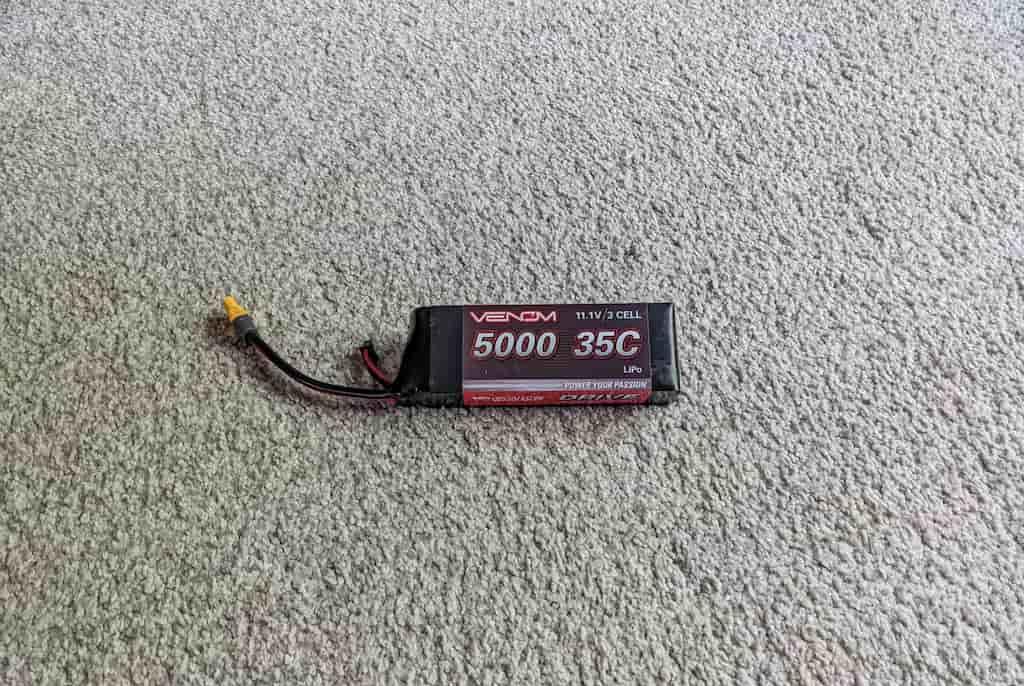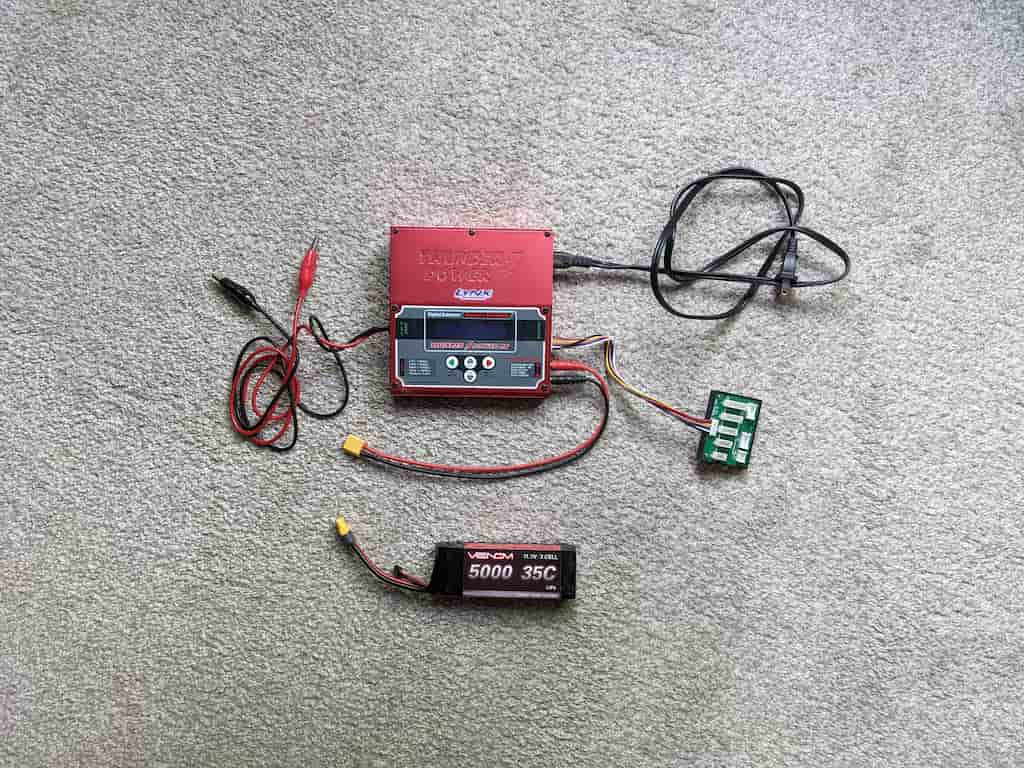Did you get a brand new RC car, drone, or airplane? If you bought an electric model, chances are it requires a Lipo battery. You have carefully unboxed your new RC vehicles and its time to charge the Lipo battery for the first time. Charging a Lipo battery takes more than just a simple charging procedure. This guide will help you do it the right way!
Many people choose LiPo batteries for their RC vehicles and may not know how to charge the batteries, especially for the first time.
That’s why I have organized this post to help you understand what LiPo batteries are, how to charge a LiPo battery for the first time safely, what voltage to use during the charging process, and recommended chargers for LiPo batteries. Lets dive in!
What Is a LiPo battery?
LiPo is a short acronym for Lithium-Polymer. In a nutshell, it is a battery made of lithium as its electrolyte and polymer material on one of the batteries’ electrodes.
Unlike traditional batteries, which use liquid electrolytes (mostly nickel-cadmium alloys), LiPo batteries transmit four times the energy because they use polymer electrolytes. These batteries are sustainable since you can recharge them. Besides, LiPo batteries are lightweight and moveable.
LiPo batteries are currently the most common type used in modern electronic gadgets since they have high energy capacity (density) for their size. That is to say that they have fewer cells (more powerful) as compared to other rechargeables.
However long these batteries can last, you should always be careful not to drain too much energy or leave them unchanged for too long. Doing so may lead to permanent damage to the batteries.

How To Charge a Brand New LiPo battery
You may have asked yourself how to charge LiPo battery for the first time when it is brand new. First, you need a LiPo charger. There are various types of chargers, but since you would like to preserve the longevity of your battery, you may start thinking about a LiPo balance charger (More about LiPo balance chargers are found in the subsequent section).
A new LiPo battery will come partially charged because the batteries are only stable at a constant voltage known as storage voltage. Additional voltages above or below the storage volt may reduce the battery’s efficiency. For this reason, it is important to charge or discharge LiPo batteries just after using them.
Here are a few steps for charging a brand new LiPo battery:
- Keeping in mind the color-coding, clip the Charger’s Positive (Red) and Negative (Black) sides onto the LiPo battery nodes using banana plugs or sometime alligator clips.
- Plug in the balance connector
- Turn the balance charger on and navigate to your models ‘Charge settings.’
- Choose battery type; for instance, LiPo battery with 3S1P (these are three cells connected in series in one parallel pack).
- Charge your battery with a charge rate of 1C (make sure to check the charge rate capabilities and follow the manufactures specifications.)
- Press the ‘Start’ button and Confirm. The battery will start charging.
What is Charge Rate for lipo batteries?
The charge rate is what amperage you can charge the battery. The charge rate of a Lipo battery is know as its “C rating” and can be calculated using a mathematical formula. The higher the C rating of the Lipo battery, the faster it will charge. That being said, it is always safer to charge a Lipo battery at a lower C rating. Slower is safer.
The formula is:
Lipo Battery mAh / 1000 = (Charging Amps) * C Rating
For a 1C 5000mAh Lipo battery the formula is:
- 5000mAh / 1000 = 5*1
- Or 5 Amps
For a 2C 5000mAh Lipo battery the formula is:
- 5000mAh / 1000 = 5*2
- Or 10 Amps
For a 3C 5000mAh Lipo battery the formula is:
- 5000mAh / 1000 = 5*3
- Or 15 Amps
LiPo Battery Amp Charge Calculator
This calculator will show you how many Amps you can charge your LiPo battery at. Make sure to read the manufacturer’s instruction on how to safely charge your LiPo battery. Do not use more Amps than the battery is designed for.
To use the calculator, add the capacity in Milliamps, the “C” rating, and how many cells (The “S” number) for your specific battery.
The results will tell you how many Amps you can safely charge your battery at. The bottom result will also tell you how many watts your charger must output to charge at the suggest Amp charge rate.
If your charger does not output enough Watts, that is ok. You simply won’t be able to charge at the full Amp rating for your battery.
The formulas for the calculator can be found here.
Is It Essential To Fully-Charge a LiPo Battery for the First Time?
Yes, it is, and here is the reason. The scientific concept behind lithium-polymer batteries is that ions flow from the positive electrode to the negative electrodes through a lithium polymer electrolyte, which acts as a conduction medium.
These ions carry charges, simply known as voltage. This concept is referred to as intercalation and deintercalation theory.
It is essential to charge your battery to 100% for the first time before use because the battery needs to maintain a higher voltage while lowering the current. Obtaining this peak voltage before using LiPo batteries improves battery capacity and longevity.
Leaving your battery under charge after 100% may cause permanent damage to the battery by initiating lithium plating.
How To Safely Charge a LiPo Battery?
I prefer to let you know that a balanced charger is a MUST when you want to charge a LiPo battery. Batteries are often discharged when left for a long time. They may slowly discharge below the storage voltage, damaging the battery.
It is the best idea to use a LiPo balanced charger as it provides a tool that allows you to charge or discharge the battery appropriately, therefore, avoiding battery damage.
Lithium Polymer batteries operate efficiently from 3V (min) to 4.2V (max). Drawing charge from the battery below the minimum voltage damages the cell. Charging past 4.2V is disastrous as the chemicals making up the polymer electrolyte may sparkle up and cause a fire.
Which Chargers Are Recommended for LiPo Batteries?
As I indicated before, if you want long battery life, stick to a balanced LiPo charger for effective LiPo battery charging. Do not use NIMH/NCID chargers to charge a LiPo battery.
LiPo balance chargers can be used for both charging and discharging. They indicate once a battery fully charges. They are also used to discharge LiPo batteries to storage voltage before storing the battery.
The charger comes with features that help balance charge and ensure battery life and user safety.
What Voltage To Charge LiPo Battery?
Before you begin charging, seek to know your battery capacity. LiPo batteries are fully charged when each cell reaches a voltage of 4.2V. Initially, the threshold charge capacity is 3.7V. If you have three cells connected in series in one pack, the batteries will generate 11.1V.
The battery is charged at a relative charge rate of 1C. If charging a 15000 Mah LiPo pack, then you would be charging it at 15 Amps. If the battery is indicated at 4000mAh, you are charging at 4 Amps for a 1C charge rate.
You may wish to improve the effectiveness and lifespan of your LiPo battery. So, you may have to charge it fully for the first time. Here are important reminders to carry home:
- Properly dispose of unused liPo batteries following the proper disposal methods.
- Never leave the battery on charge as it may burst into a chemical fire.
- Always keep the battery away from intent heat or temperatures.
- Do not store or charge LiPo batteries inside a damaged store.
Get Started
A well-charged and maintained lithium polymer battery will offer you a long-lasting power solution for any gadget. Now that you know how to charge LiPo battery for the first time, keep these tips and information in mind to ensure you get the most out of it.
FAQs
Here are some frequently asked questions about charging your LiPo battery.
Can you use your LiPo battery while it’s charging?
You may be able to use it, but it doesn’t mean you should. This can shorten the lifetime and may even damage your battery.
What is the lifespan of a LiPo battery?
The life expectancy of a LiPo may range from 2 to 3 years.

